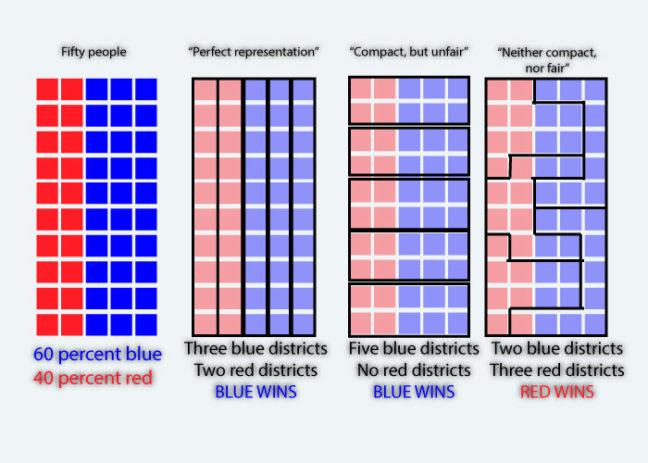How does a state elect a national Democratic senator by a ten-point margin, a Democratic governor for the first time in eight years and a near-Republican super majority in the state legislature? Maybe Wisconsin voters believe in bipartisan government and split tickets. Maybe Republicans handle local issues better and are more in touch with their districts. Or maybe the state is gerrymandered to all hell.
Gerrymandering is the practice of drawing legislative districts so as to give one group an electoral advantage. Two of the most widely used practices of gerrymandering include “packing and cracking.” In Wisconsin, legislators “packed” Democrats into some districts, ensuring the district goes blue and “cracked” other Democratic strongholds into several districts, giving Republicans narrow majorities in multiple districts.
The 2018 midterm results indicate Republicans and Democrats are resigned to this fact. Of the Democrats’ 35 seats won in the midterms, 80 percent were uncontested. Of Republicans’ 64 seats, only four percent were uncontested. Why would the Republican party not field candidates in 28 state districts? Because these districts are “packed” with Democratic voters. Why would Democrats field a candidate in every district but three? Because many of these districts have “cracked” Democratic blocs and narrow victory margins. Of the 68 contested races, 41 percent had a margin of victory fewer than 5,000 votes. With margins that tight, district lines matter.
Assembly Speaker Robin Vos, R-Rochester, denied claims of state gerrymandering. Vos claims the district map accurately represents Wisconsin and said, “[Democrats] only playing to Madison and Milwaukee and not representing the other 70 counties.” Maybe that’s true. But Vos’ party also made the map.
State redistricting occurs every census year. In Wisconsin, the State Legislature redraws the districts lines and the maps are approved by the governor. The current maps, approved in 2011, were redrawn by a Republican legislature and signed by a Republican governor. Republicans gave themselves an electoral advantage because they controlled every step of the redistricting process. This conflict of interest was not checked. How do we fix the redistricting problem?
There are smarter ways to redistrict. Six states have independent commissions who draw and approve maps. The members of the commission are not directly impacted by the map, resulting in non-partisan redistricting.
Another possibility comes from the U.S. Supreme Court case Gill vs. Whitford. This case addresses partisan gerrymandering at the national level. After the Supreme Court refused to rule on the case in May, plaintiffs may retry the case in 2019.
The most likely solution is Gov.-elect Tony Evers checking the Wisconsin legislature and demanding fair maps after the 2020 census. While this might solve the problem for the next decade, it does not solve the root problem — having state legislatures redraw maps is a conflict of interest.
Regardless of party affiliation, gerrymandering is more than alarming. It distorts elections, makes outcomes less democratic, less representative and allows existing legislators to consolidate their hold on power. It’s politics or statesmanship — Wisconsin deserves better.
Michael Warren (mwarren5@wisc.edu) is a junior majoring in journalism and economics.


